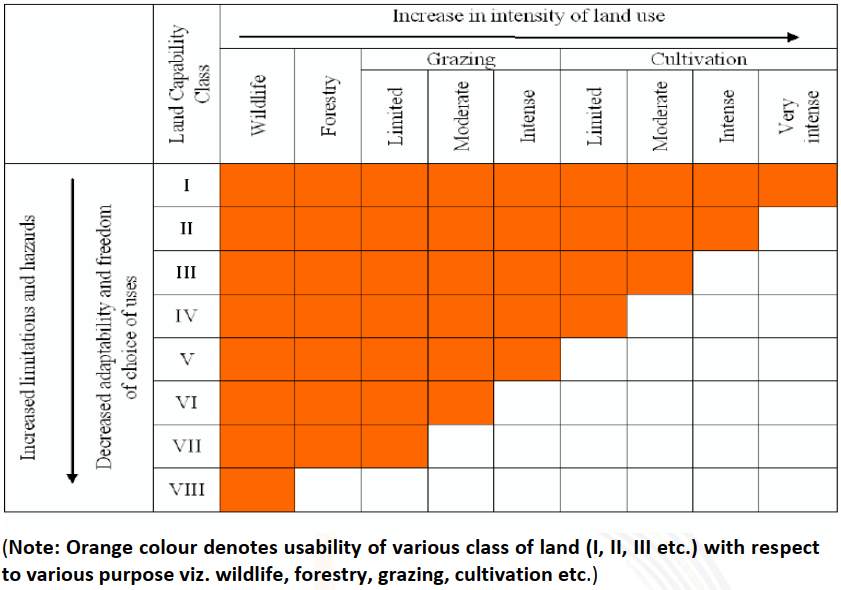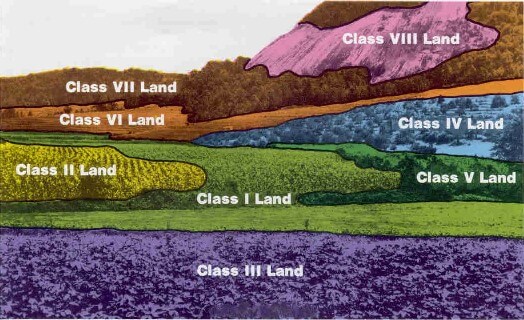In this article, You will read Land Capability & Land capability Class – for UPSC IAS.
Land Capability
- Land capability survey was devised by the Commonwealth Scientific and Industrial research Organisation (CSIRO) for demarcation of land capability regions of Australia. Subsequently the capability survey was widely applied in European and AngloAmerican countries and in some of the Third World Countries.
- Land capability may be defined as the ability of the land surface to support natural plant growth/ wildlife habitat or artificial crop growth/ human habitat. Thus, it indicates the type of land use [viz., human habitation, agriculture, pastures, forests, wildlife habitat, etc.] that is suitable over a particular type of land.
- Land capability survey helps in ascertaining the usefulness of land, its utility for agriculture, forest, industry, tourism, and other land use purpose.
- For the delineation of land capability regions, only physical parameters are taken into consideration. The demarcation of these regions in fact is on the basis of texture, structure of soil, terrain, slope, run-off, temperature, and precipitation. Thus, in the land capability survey, there is a heavy reliance on the results of soil survey in pedological conditions.
- In general each soil group has its own physical and chemical properties. These properties determine the land capability and land suitability. For example, the regur soil is good for the cultivation of cotton, sugarcane and citrus fruits, while the alluvial soil is utilised for wheat, rice, maize, sugarcane, pulses, and oilseeds.
- In India, the basic objective of the soil survey was to achieve the land capability classification. The All India Soil and land Use Survey Organization attempted the land capability survey in 1960 which identified eight land use capability classes.
Land Suitable For Cultivation
- Class I: Very good arable land with no specific difficulty in farming. It is nearly levelled, well drained, easily worked soil. These soils are very productive.
- Class II: Good cultivation land which needs protection from erosion or floods, drainage improvement and conservation of irrigation water, intensive drainage, and protection from floods.
- Class III: Moderately good cultivation land where special attention has to be paid to erosion control, conservation of irrigation water, intensive drainage, and protection from floods.
- Class IV: Fairly goof land suited for occasional and limited cultivation. It needs intensive erosion control, intensive drainage and very intensive treatment to overcome the soil limitations.

Land Not Suitable For Cultivation
- Class V: Very well suited for grazing and forestry but not for cultivation of crops. It has very good carrying capacity of livestock but needs protection from gullying.
- Class VI: Well suited for grazing and forestry but not for cultivation of crops. It has moderately carrying capacity of livestock. This land has steep slope, severe erosion, and stoniness, poor moisture retaining capacity, salinity and severe climate.
- Class VII: Fairly well suited for grazing or forestry with little carrying capacity of livestock.
- Class VIII: Suited only for wildlife. This land has severe climate, wet soil, stones, badlands, sandy beaches, marshes, deserts, and nearly barren lands.

Significance Of Land Capability Classification In Landuse Planning
- The land capability classification determines the use ceiling for any piece of land and helps to define the conservation problems and possible treatments. Keeping this in mind, a piece of land can be put to the most efficient land use. For instance, all agricultural activity must be confined to classes I to IV and others, such as pasturelands, energy plantation, buildings, roads, etc., to classes V to VIII. Within this scheme, one can select the most suitable crop for a particular piece of land.
- The land capability classes can change towards better classes, if the existing limitations can be permanently removed or reduced in extent by economically feasible reclamation measures, such as providing irrigation, providing proper drainage, constructing flood-control measures or stabilising, gullies. A further deterioration of existing conditions can, on the other hand, shift the capability to poorer classes.

very nice information .